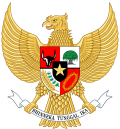Revised Dwikora Cabinet Kabinet Dwikora Yang Disempurnakan | |
|---|---|
| 24th Cabinet of Indonesia | |
| 1966 | |
 | |
| Date formed | 24 February 1966 |
| Date dissolved | 27 March 1966 |
| People and organisations | |
| Head of state | Sukarno |
| Head of government | Sukarno |
| No. of ministers | 109 ministers |
| History | |
| Predecessor | Dwikora I Cabinet |
| Successor | Dwikora III Cabinet |
| ||
|---|---|---|
Pre-independence Domestic policy Foreign policy Family | ||
| Gallery: Picture, Sound, Video | ||
The Revised Dwikora Cabinet (Indonesian : Kabinet Dwikora Yang Disempurnakan) was the Indonesian cabinet which served under President Sukarno from February 1966 to March 1966. The cabinet was formed under an extremely tense political situation, and it was expected that this cabinet would address the concerns of the people. It was during a meeting of this cabinet that unidentified troops surrounded the Presidential Palace causing to Sukarno to escape to Bogor from where he gave Supersemar to Lieutenant General Suharto.
Contents
- President
- Cabinet Presidium
- Ministers in the Field of Law and Home Affairs
- Ministers in the Field of Defense and Security
- Ministers in the Field of Finance
- Ministers in the Field of Development
- Ministers in the Field of People's Industries
- Ministers in the Field of Public Works and Energy
- Ministers in the Field of Agriculture and Agrarian Affairs
- Ministers in the Field of Distribution
- Ministers in the Field of Maritime Affairs
- Ministers in the Field of Welfare
- Ministers in the Field of Religious Affairs
- Ministers in the Field of Education and Culture
- Ministers in the Field of Communication with the People
- Presidential Advisers
- State Ministers Attached to the Cabinet Presidium
- State Officials
- Officials with Ministerial status
- Changes
- External links
- References

